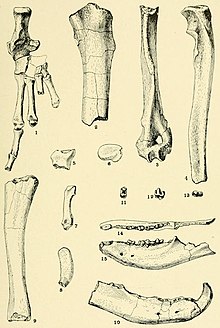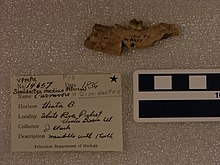Simidectes
Simidectes (Симидектес — „симивалијска животиња која гризе”) је изумрли род плаценталних сисара из изумрле породице Simidectidae унутар кладуса Pan-Carnivora, који је у периоду средњег еоцена настањивао подручје Сјеверне Америке.[3][4][5]
| Simidectes Временски распон: средњи еоцен
| |
|---|---|

| |
| илустрација фосилни остатака врсте Simidectes magnus | |

| |
| дио доње вилице врсте Simidectes medius | |
| Научна класификација | |
| Домен: | Eukaryota |
| Царство: | Animalia |
| Тип: | Chordata |
| Класа: | Mammalia |
| Мироред: | Ferae |
| Кладус: | Pan-Carnivora |
| Породица: | †Simidectidae Prothero, 2016[1] |
| Род: | †Simidectes Stock, 1933 |
| Типска врста | |
| †Simidectes magnus Peterson, 1919
| |
| Врсте | |
| |
| Синоними | |
|
синоними рода:
синоними врсте:
| |
Етимологија назива
уреди| Породица: | Поријекло назива од: | Значење назива: |
|---|---|---|
| Simidectidae |
|
симивалијске животиње које гризу |
| Род: | Поријекло назива од: | Значење назива: |
|---|---|---|
| Simidectes |
|
симивалијска животиња која гризе |
| Врсте: | Поријекло назива од: | Значење назива: |
|---|---|---|
| S. magnus |
|
велики Симидектес |
| S. medius |
|
средњи Симидектес |
| S. merriami |
|
меријамов Симидектес |
Систематика
уредиИсторија класификације
уредиОд како је први пут описан, тачан положај рода Simidectes је био непознат. Једно вријеме, овај род је био уврштаван унутар изумрли редова Mesonychia[6] и Pantolesta.[7][5][8] У истраживањима из 2016. и 2023. године је овај род препознат као близак сродник изумрлог реда Hyaenodonta.[9][10][11]
Класификација
уреди| Врсте: | Распрострањеност фосила и локација: |
Временски распон: |
|---|---|---|
| †S. magnus (Peterson, 1919)[12] | САД (Јута и Тексас[13][14][15]) | 46,2 до 37,0 мил. год. |
| †S. medius (Peterson, 1919) | САД (Јута и Калифорнија) | 46,2 до 39,7 мил. год. |
| †S. merriami (Stock, 1933)[16] | САД (Калифорнија) | 42,8 до 39,7 мил. год. |
| †S. sp. [FMNH PM 61190] (Tomiya, 2021)[10] | САД (Вајоминг) | 47,0 до 46,2 мил. год. |
| †S. sp. [San Diego County, Southern California] (Zack, 2023)[11] | САД (Калифорнија) | 46,2 до 45,7 мил. год. |
Филогенија
уредиДоље приказан кладограм представља филогенетске везе рода Simidectes.[17][18][19]
| Ferae |
| ||||||||||||||||||||||||||||||||||||||||||||||||||||||||||||||||
Временска распрострањеност рода Simidectes унутар кладуса Pan-Carnivora
уреди
Види још
уредиРеференце
уреди- ^ Prothero, Donald R. (2016). The Princeton Field Guide to Prehistoric Mammals. Princeton University Press. стр. 125. ISBN 9781400884452.
- ^ Lucas J. Kraglievich (1948.) "Substitucion de un nombre generico." An. Soc. Cient. Argentina, E. 3, vol. 146, pp. 161-162.
- ^ J. J. Hooker (1986.) "Mammals from the Bartonian (middle/late Eocene) of the Hampshire Basin, southern England." Bulletin of the British Museum (Natural History) 39(4):191-478
- ^ Carroll, Robert L. (1988). Vertebrate Paleontology and Evolution (PDF). New York: W. H. Freeman and Company. стр. 1—698. ISBN 978-0-7167-1822-2.
- ^ а б McKenna, Malcolm C.; Bell, Susan K. (1997). Classification of Mammals Above the Species Level. New York: Columbia University Press. ISBN 978-0-231-11012-9. Приступљено 16. 3. 2015.
- ^ P. D. Gingerich (1982.) "Second Species of Wyolestes (Condylarthra, Mesonychia") from the Early Eocene of Western North America". Journal of Mammalogy 63(4)
- ^ M. C. Coombs (1971.) "Status of Simidectes (Insectivora, Pantolestoidea) of the late Eocene of North America." American Museum Novitates 2455
- ^ Gregg F. Gunnell, Thomas Bown, Jonathan Ivan Bloch, Doug M. Boyer (2008.) "Proteutheria"; pp. 63–81 in C. M. Janis, G. F. Gunnell, and M. Uhen (eds.), "Evolution of Tertiary Mammals of North America. Volume 2: Small Mammals, Xenarthrans, and Marine Mammals." Cambridge University Press, Cambridge, U.K.
- ^ S. P. Zack and S. Tomiya (2016.) "New postcrania clarify the affinities of the unusual Eocene mammal Simidectes", in "The Society of Vertebrate Paleontology 76th annual meeting"
- ^ а б Tomiya, S.; Zack, S. P.; Spaulding, M.; Flynn, J. J. (2021). „Carnivorous mammals from the middle Eocene Washakie Formation, Wyoming, USA, and their diversity trajectory in a post-warming world”. Journal of Paleontology. 95 (Supplement S82): 1—115. doi:10.1017/jpa.2020.74.
- ^ а б Zack, Shawn P. (2023.) "A new species of Simidectes from the early Uintan of California clarifies the affinities of the genus", in "The Society of Vertebrate Paleontology 83rd annual meeting"
- ^ O. A. Peterson (1919.) "Report Upon the Material Discovered in the Upper Eocene of the Uinta Basin by Earl Douglas in the Years 1908-1909, and by O. A. Peterson in 1912." Annals of Carnegie Museum 12(2):40-168
- ^ E. P. Gustafson (1979.) "Early Tertiary Vertebrate Faunas Big Bend Area Trans-Pecos Texas: Simidectes (Mammalia, Insectivora)." Pearce-Sellards Series 31
- ^ J. A. Wilson and M. S. Stevens (1986.) "Fossil vertebrates from the latest Eocene, Skyline channels, Trans-Pecos Texas." Contributions to Geology, University of Wyoming Special Paper 3:221-235
- ^ J. W. Westgate (1990.) "Uintan Land Mammals (Excluding Rodents) From an Estuarine Facies of the Laredo Formation (Middle Eocene, Claiborne Group) of Webb County, Texas." Journal of Paleontology 64(3):454-468
- ^ C. Stock (1933.) "A miacid from the Sespe Upper Eocene, California." Proceedings of the National Academy of Sciences 19(5):481-486
- ^ Borths, Matthew R.; Stevens, Nancy J. (2017). „Deciduous dentition and dental eruption of Hyainailouroidea (Hyaenodonta, "Creodonta," Placentalia, Mammalia)”. Palaeontologia Electronica. 20 (3): 55A. doi:10.26879/776 .
- ^ Prevosti, F. J. & Forasiepi, A. M. (2018.) "Introduction. Evolution of South American Mammalian Predators During the Cenozoic: Paleobiogeographic and Paleoenvironmental Contingencies", Springer Geology. Springer, Cham.
- ^ Floréal Solé; Bernard Marandat; Fabrice Lihoreau (2020). „The hyaenodonts (Mammalia) from the French locality of Aumelas (Hérault), with possible new representatives from the late Ypresian”. Geodiversitas. 42 (13): 185—214. doi:10.5252/geodiversitas2020v42a13.